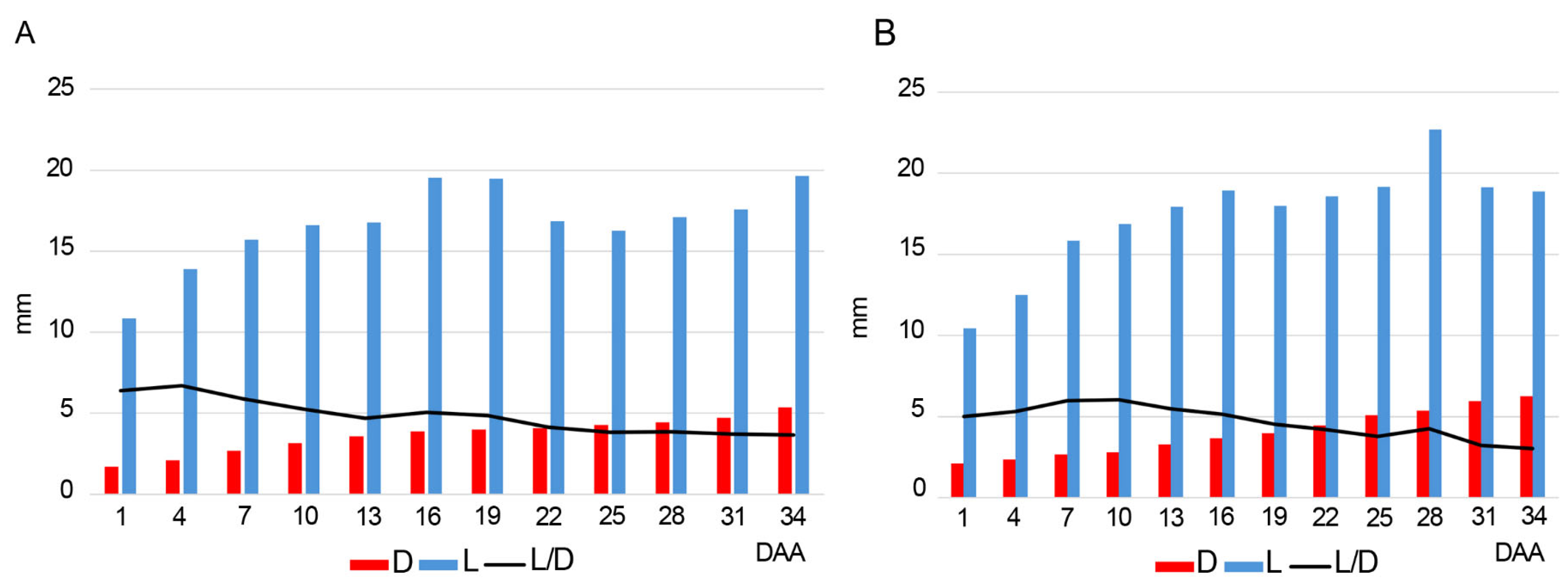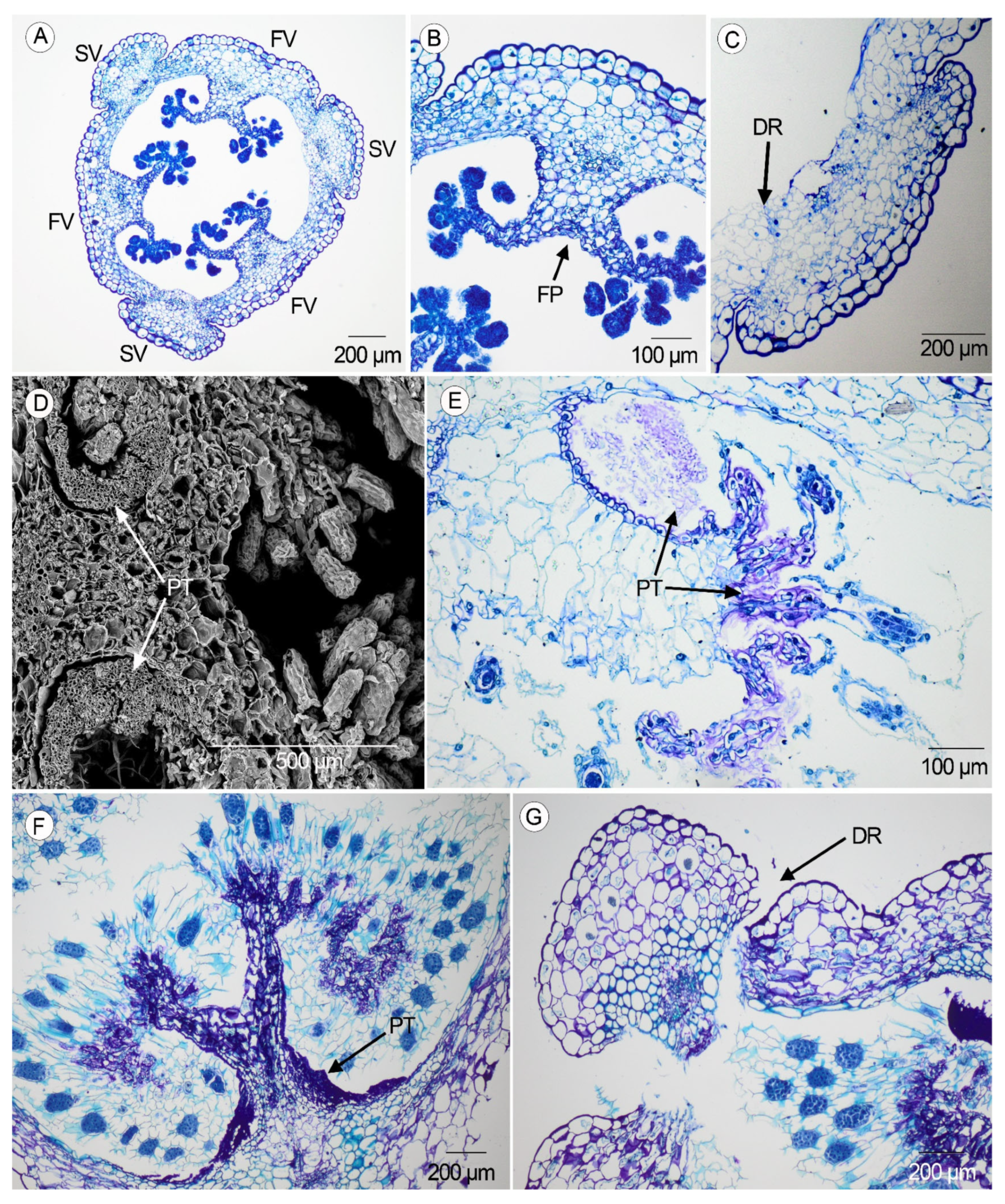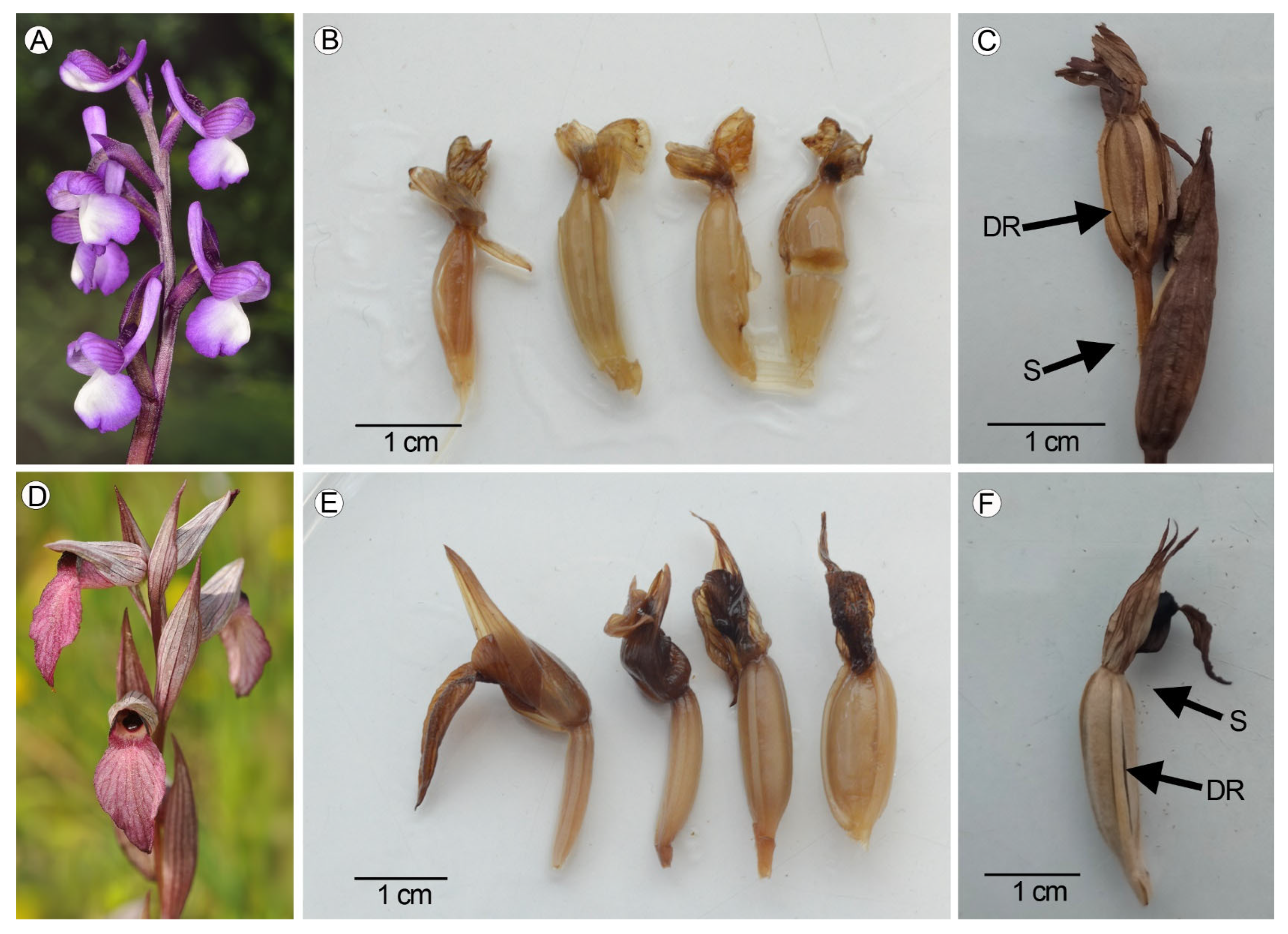Characterization of Fruit and Seed Development in the Genera Anacamptis and Serapias (Orchidaceae)
Abstract
:1. Introduction
2. Results
2.1. Diameter and Length of the Ovaries
2.2. Anatomical Development of the Ovary and the Pericarp
2.3. Ripening of Seeds
2.4. Lignification
2.5. Raphides
3. Discussion
4. Materials and Methods
4.1. Plant Material and Fixation
4.2. Microscopic Study
5. Conclusions
Supplementary Materials
Author Contributions
Funding
Data Availability Statement
Acknowledgments
Conflicts of Interest
References
- Sharp, L.W. The orchid embryo sac. Bot. Gaz. 1912, 54, 372–385. [Google Scholar] [CrossRef]
- Swamy, B.G.M. Embryology of Orchidaceae. Curr. Sci. 1943, 12, 13–17. [Google Scholar]
- Vij, S.P.; Sharma, M. Embryo sac development in Orchidaceae. In Biology, Conservation and Culture of Orchids; Vij, S.P., Ed.; Affiliated East-West Press: New Delhi, India, 1986; pp. 31–48. [Google Scholar]
- Yeung, E.C.; Law, S.K. Ovule and megagametophyte development in orchids. In Orchid Biology: Reviews and Perspectives, VII; Arditti, J., Pridgeon, A.M., Eds.; Kluwer Academic Publishers: Dordrecht, The Netherlands, 1997; pp. 31–73. [Google Scholar]
- Lee, Y.; Lee, N.; Yeung, E.C.; Chung, M.-C. Embryo development of Cypripedium formosanum in relation to seed germination in vitro. J. Amer. Soc. Hort. Sci. 2005, 130, 752–753. [Google Scholar] [CrossRef]
- Carlson, M.C. Formation of the seed of Cypripedium parviflorum. Bot. Gaz. 1940, 102, 295–301. [Google Scholar] [CrossRef]
- Duncan, R.E.; Curtis, J.T. Intermittent growth of fruits of Cypripedium and Paphiopedilum. A correlation of orchid fruits with their internal development. Bull. Torrey Bot. Club 1942, 69, 353–359. [Google Scholar] [CrossRef]
- Mayer, J.L.S.; Carmello-Guerreiro, S.M.; Appezzato-da-Glória, B. Anatomical development of the pericarp and seed of Oncidium flexuosum Sims (Orchidaceae). Flora 2011, 206, 601–609. [Google Scholar] [CrossRef]
- Dirks-Mulder, A.; Ahmed, I.; Uit Het Broek, M.; Krol, L.; Menger, N.; Snier, J.; van Winzum, A.; de Wolf, A.; Van’t Wout, M.; Zeegers, J.J.; et al. Morphological and molecular characterization of orchid fruit development. Front. Plant Sci. 2019, 10, 137. [Google Scholar] [CrossRef]
- Yeung, E.C. The orchid embryo—“An embryonic protocorm”. Botany 2022, 100, 691–706. [Google Scholar] [CrossRef]
- Vafaee, Y.; Mohammadi, G.; Nazari, F.; Fatahi, M.; Kaki, A.; Gholami, S.; Ghorbani, A.; Khadivi, A. Phenotypic characterization and seed-micromorphology diversity of the threatened terrestrial orchids: Implications for conservation. S. Afr. J. Bot. 2021, 137, 386–398. [Google Scholar] [CrossRef]
- Rasmussen, F.N.; Johansen, B. Carpology of Orchids. Selbyana 2006, 27, 44–53. [Google Scholar]
- Mosquera-Mosquera, H.R.; Valencia-Barrera, R.M.; Acedo, C. Variation and evolutionary transformation of some characters of the pollinarium and pistil in Epidendroideae (Orchidaceae). Plant Syst. Evol. 2019, 305, 353–374. [Google Scholar] [CrossRef]
- Süngü Seker, S.; Akbulut, M.K.; Senel, G. Pericarp anatomy and surface micromorphology of some orchids in the Black Sea Region. Anatol. J. Bot. 2020, 4, 69–75. [Google Scholar] [CrossRef]
- Guignard, L. Sur la pollinisation et ses effects chez les Orchidées. Ann. Sci. Nat. Bot. 1886, 4, 202–240. [Google Scholar]
- Veyret, Y. Embryogénie Comparée Et Blastogénie Chez Les Orchidaceae-Monandrae; Office de la Recherche Scientifique et Technique Outre-mer: Paris, France, 1965. [Google Scholar]
- Vij, S.P.; Kaur, P.; Kaur, S.; Kaushal, P.S. The orchid seeds: Taxonomic, evolutionary and functional aspects. J. Orchid Soc. India 1992, 6, 91–107. [Google Scholar]
- Arditti, J.; Ghani, A.K.A. Tansley Review No. 110. Numerical and physical properties of orchid seeds and their biological implications. New Phytol. 2000, 145, 367–421. [Google Scholar] [CrossRef]
- Pridgeon, A.M.; Cribb, P.J.; Chase, M.W.; Rasmussen, F.N. Genera Orchidacearum: Volume 2: Orchidoideae (Part 1); Oxford University Press: Oxford, UK, 2001. [Google Scholar]
- Kretzschmar, H.; Eccarius, W.; Dietrich, H. The Orchid Genera Anacamptis, Orchis, Neotinea; EchinoMedia: Bürgel, Germany, 2007. [Google Scholar]
- Kühn, R.; Pedersen, K.A.; Cribb, P. Field Guide to the Orchids of Europe and the Mediterranean; Kew Publishing: Kew, Australia, 2019. [Google Scholar]
- Akçin, T.; Ozdener, Y.; Akçin, A. Taxonomic value of seed characters in orchids from Turkey. Belg. J. Bot. 2009, 142, 124–139. [Google Scholar]
- Gamarra, R.; Ortúñez, E.; Galán Cela, P.; Guadaño, V. Anacamptis versus Orchis (Orchidaceae): Seed micromorphology and its taxonomic significance. Plant Syst. Evol. 2012, 298, 597–607. [Google Scholar] [CrossRef]
- Barthlott, W.; Große-Veldmann, B.; Korotkova, N. Orchid Seed Diversity: A Scanning Electron Microscopy Survey. Englera 2014, 32, 3–245. [Google Scholar]
- Vasudevan, R.; Van Staden, J. Fruit harvesting time and corresponding morphological changes of seed integuments influence in vitro seed germination of Dendrobium nobile Lindl. Plant Growth Regul. 2010, 60, 237–246. [Google Scholar] [CrossRef]
- Udkhiawati, I.; Solichatun; Pitoyo, A. Characterization of pollen development and female reproductive structure of Phalaenopsis amabilis after pollination. Cell Biol. Dev. 2020, 4, 17–25. [Google Scholar] [CrossRef]
- Pandolfi, T.; Pacini, E. The pollinium of Loroglossum hircinum (Orchidaceae) between pollination and pollen tube emission. Plant Syst. Evol. 1995, 196, 141–151. [Google Scholar] [CrossRef]
- Galán Cela, P.; Seligrat, I.; Ortúñez, E.; Gamarra, R.; Vivar, A.; Scrugli, A. A study of seed micromorphology in the genus Ophrys (Orchidaceae). Anal. Jard. Bot. Madr. 2014, 71, e008. [Google Scholar] [CrossRef]
- Ortúñez, E.; Gamarra, R. Seed morphology, life form and distribution in three Bromheadia species (Epidendroideae, Orchidaceae). Diversity 2023, 15, 195. [Google Scholar] [CrossRef]
- Rasmussen, F.N. Terrestrial Orchids: From Seed to Mycotrophic Plant; Cambridge University Press: Cambridge, UK, 1995. [Google Scholar]
- Gamarra, R.; Ortúñez, E.; Galán Cela, P.; Merencio, Á. Seed micromorphology of Orchidaceae in the Gulf of Guinea (West Tropical Africa). Plant Syst. Evol. 2018, 304, 665–677. [Google Scholar] [CrossRef]
- Gamarra, R.; Ortúñez, E.; Sanz, E.; Esparza, I.; Galán Cela, P. Seeds in subtribe Orchidinae (Orchidaceae): The best morphological tool to support molecular analyses. In Tools for Identifying Biodiversity: Progress and Problems; Nimis, P.L., Vignes Lebbe, R., Eds.; Edizioni Università di Trieste: Trieste, Italy, 2011; pp. 323–326. [Google Scholar]
- Bateman, R.M.; Hollingsworth, P.M.; Preston, J.C.; Yi-bo, L.; Pridgeon, A.M.; Chase, M.W. Molecular phylogenetics and evolution of Orchidinae and selected Habenariinae (Orchidaceae). Bot. J. Linn. Soc. 2003, 142, 1–40. [Google Scholar] [CrossRef]
- Inda, L.A.; Pimentel, M.; Chase, M.W. Phylogenetics of tribe Orchideae (Orchidaceae: Orchidoideae) based on combined DNA matrices: Inferences regarding timing of diversification and evolution of pollination syndromes. Ann. Bot. 2012, 110, 71–90. [Google Scholar] [CrossRef]
- Franceschi, V.R.; Nakata, P.A. Calcium oxalate in plants: Formation and function. Annu. Rev. Plant Biol. 2005, 56, 41–71. [Google Scholar] [CrossRef]
- Prychid, C.J.; Rudall, P.J. Calcium oxalate crystals in Monocotyledons: A review of their structure and systematics. Ann. Bot. 1999, 84, 725–739. [Google Scholar] [CrossRef]
- Nishimura, G.; Yukawa, T. Dark material accumulation and sclerotization during seed coat formation in Vanilla planifolia Jacks. ex Andrews (Orchidaceae). Bull. Natl. Mus. Nat. Sci. Tokyo B 2010, 36, 33–37. [Google Scholar]
- Pansarin, E.R. Unravelling the enigma of seed dispersal in Vanilla. PLoS Biol. 2021, 23, 974–980. [Google Scholar] [CrossRef]
- Kausch, A.P.; Horner, H.T. Increased nuclear DNA content in raphide crystal idioblasts during development in Vanilla planifolia L. (Orchidaceae). Eur. J. Cell Biol. 1984, 33, 7–12. [Google Scholar] [PubMed]
- Moreira, A.S.; Filho, J.P.; Isaias, R.M. Structural adaptations of two sympatric epiphytic orchids (Orchidaceae) to a cloudy forest environment in rocky outcrops of Southeast Brazil. Rev. Biol. Tróp. 2013, 61, 1053–1065. [Google Scholar] [CrossRef] [PubMed]
- Ataşlar, E. Morpho-anatomical structure of Orchis mascula (L.) L. and its contribution to the taxonomy of Orchidaceae. Eur. Int. J. Sci. Technol. 2018, 7, 1–8. [Google Scholar]
- Senel, G.; Süngü Seker, S.; Akbulut, M.K.; Akçin, Ö.E. An integrative anatomical, morphological, micromorphological and molecular approach to Turkish epidendroid and orchidoid species (Orchidaceae). Nordic J. Bot. 2018, 36, e01700. [Google Scholar] [CrossRef]








| Range of DAA | Ovary to Fruit | Ovules to Seeds |
|---|---|---|
| 1–7 | Increase in length and diameter Increase in the valves area Proliferation of placentae | Globose primordial ovules |
| 10–16 | Increase in length and diameter Increase in the valves area Beginning of the differentiation of the dehiscence region between sterile and fertile valves | Elongation of the ovules, becoming anatropous and bitegmic |
| 19–28 | Increase in diameter Increase in the valves area (principally, fertile valves) Input of the pollen tubes Beginning of the lignification of the endocarp cells in the placenta region Lignification of vascular bundles | Differentiation of the testa in the immature seeds Formation of the air space between embryo and testa |
| 31–34 | Increase in diameter Pollen tubes collapse Full lignification of the endocarp cells in the placenta region and vascular bundles Decrease in the valves area Sterile valves detached Dehiscence of the fruit | Full development of the embryo and the air space surrounding it Lignification of the walls in the testa seed Ornamentation of the periclinal walls |
Disclaimer/Publisher’s Note: The statements, opinions and data contained in all publications are solely those of the individual author(s) and contributor(s) and not of MDPI and/or the editor(s). MDPI and/or the editor(s) disclaim responsibility for any injury to people or property resulting from any ideas, methods, instructions or products referred to in the content. |
© 2025 by the authors. Licensee MDPI, Basel, Switzerland. This article is an open access article distributed under the terms and conditions of the Creative Commons Attribution (CC BY) license (https://creativecommons.org/licenses/by/4.0/).
Share and Cite
Ortúñez, E.; Pérez-Guillén, A.; Gamarra, R. Characterization of Fruit and Seed Development in the Genera Anacamptis and Serapias (Orchidaceae). Plants 2025, 14, 1229. https://doi.org/10.3390/plants14081229
Ortúñez E, Pérez-Guillén A, Gamarra R. Characterization of Fruit and Seed Development in the Genera Anacamptis and Serapias (Orchidaceae). Plants. 2025; 14(8):1229. https://doi.org/10.3390/plants14081229
Chicago/Turabian StyleOrtúñez, Emma, Alegría Pérez-Guillén, and Roberto Gamarra. 2025. "Characterization of Fruit and Seed Development in the Genera Anacamptis and Serapias (Orchidaceae)" Plants 14, no. 8: 1229. https://doi.org/10.3390/plants14081229
APA StyleOrtúñez, E., Pérez-Guillén, A., & Gamarra, R. (2025). Characterization of Fruit and Seed Development in the Genera Anacamptis and Serapias (Orchidaceae). Plants, 14(8), 1229. https://doi.org/10.3390/plants14081229






